Popular categories
Looking for a yarn?
Order DROPS Kid-Silk from Wool Warehouse Direct Ltd

|
DROPS Kid-Silk uni colour 75% Mohair, 25% Silk |
4.60 £ /25g |
Order |
Clicking the ORDER button will redirect you to Wool Warehouse Direct Ltd website
Order DROPS Needles & Hooks
Clicking the ORDER button will redirect you to Wool Warehouse Direct Ltd website
The yarn cost is calculated from the pattern’s smallest size and the yarn’s cheapest product type. Looking for an even better price? You might find it on the DROPS Deals!
Sunday Vibes
Knitted jumper in DROPS Sky and DROPS Kid-Silk. The piece is worked top down, with textured pattern and saddle shoulders. Sizes S - XXXL.
DROPS Design: Pattern no sk-106
Yarn group B + A
-------------------------------------------------------
SIZES:
S - M - L - XL - XXL - XXXL
MATERIALS:
DROPS SKY from Garnstudio (belongs to yarn group B)
200-250-250-300-300-350 g colour 03, light beige
and use:
DROPS KID-SILK from Garnstudio (belongs to yarn group A)
100-100-100-125-125-150 g colour 20, light beige
KNITTING TENSION:
15 stitches in width and 24 rows in height with textured pattern (= A.1) and 1 strand of each quality = 10 x 10 cm.
NEEDLES:
DROPS CIRCULAR NEEDLE SIZE 6 MM: Length 40 cm and 80 cm.
Needle size is only a guide. If you get too many stitches on 10 cm, change to a larger needle size. If you get too few stitches on 10 cm, change to a smaller needle size.
-------------------------------------------------------
Alternative Yarn – See how to change yarns here
Yarn Groups A to F – Use the same pattern and change the yarn here
Yarn usage using an alternative yarn – Use our yarn converter here
-------------------------------------------------------
Order DROPS Sky from Wool Warehouse Direct Ltd

|
DROPS Kid-Silk uni colour 75% Mohair, 25% Silk 4.60 £ /25g Order |
Clicking the ORDER button will redirect you to Wool Warehouse Direct Ltd website
Order DROPS Needles & Hooks
Clicking the ORDER button will redirect you to Wool Warehouse Direct Ltd website
The yarn cost is calculated from the pattern’s smallest size and the yarn’s cheapest product type. Looking for an even better price? You might find it on the DROPS Deals!
- English (UK/cm)
- Česky - not translated
- Dansk
- Deutsch
- Eesti keel - not translated
- English (US/in)
- Español
- Français
- Íslenska
- Italiano
- Magyar
- Nederlands
- Norsk
- Polski
- Português
- Suomi
- Svenska
- English (UK/cm), Bulgaria
- English (UK/cm), Croatia
- English (UK/cm), Greece
- English (UK/cm), Latvia
- English (UK/cm), Lithuania
- English (UK/cm), Romania
- English (UK/cm), Slovenia
- Česky, Slovakia - not translated
Pattern instructions
EXPLANATIONS FOR THE PATTERN:
-------------------------------------------------------
RIDGE/GARTER STITCH (worked back and forth):
Knit all rows.
1 ridge in height = Knit 2 rows.
PATTERN:
See diagram A.1. The diagram shows all rows in the pattern from the right side.
INCREASE TIP (for saddle shoulder increase):
BEFORE MARKER:
The new stitch will be twisted, leaning towards the right.
Use left needle to pick up strand between 2 stitches from the round below, pick up strand from behind and knit stitch in front loop.
AFTER MARKER:
The new stitch will be twisted, leaning towards the left.
Use left needle to pick up strand between 2 stitches from the round below, pick up strand from the front and knit stitch in back loop.
DECREASE TIP (for sleeves):
All decreases are worked from the right side!
Decrease 1 stitch inside the 1 edge stitch on each side as follows:
Work 1 edge stitch in garter stitch, slip 1 stitch as if to knit, knit 1 and pass the slipped stitch over the knitted stitch (= 1 stitch decreased), work until there are 3 stitches left, knit 2 together (= 1 stitch decreased) and 1 edge stitch in garter stitch.
CASTING-OFF TIP:
To avoid the cast-off edge being tight you can cast off with a larger size needle. If the edge is still tight, make 1 yarn over after approx. each 4th stitch at the same time as casting off; the yarn overs are cast off as normal stitches.
-------------------------------------------------------
START THE PIECE HERE:
-------------------------------------------------------
JUMPER – SHORT OVERVIEW OF THE PIECE:
The neck and yoke are worked in the round with circular needle, top down, until the increases for saddle shoulders are finished. The shoulder stitches are placed on threads and the front and back piece finished back and forth, separately. The sleeves are worked back and forth with circular needle, top down.
NECK:
Cast on 64-72-72-80-80-88 stitches with circular needle size 6 mm, 1 strand Sky and 1 strand Kid-silk (= 2 strands). Knit 1 round, then work pattern A.1 in the round for 12 cm. REMEMBER THE KNITTING TENSION!
Insert 1 marker at the beginning of the round (= approx. mid-back), the piece is measured from the first marker!
Insert 4 more markers as follows: Insert 1st marker after 8-12-12-12-12-16 stitches (= half back piece), count 14-14-14-18-18-18 stitches (= shoulder), insert 2nd marker here, count 18-22-22-22-22-26 stitches (= front piece), insert 3rd marker here, count 14-14-14-18-18-18 stitches (= shoulder), insert 4th marker here, there are 10-10-10-10-10-10 stitches left on the round (= half back piece).
SADDLE SHOULDER INCREASE:
Continue with the pattern as before, and increase 4 stitches on round:
Increase BEFORE 1st and 3rd marker, and AFTER 2nd and 4th marker – read INCREASE TIP. Increases are only on front piece and back piece and number of shoulder stitches remains the same. Increase like this every round 18-18-22-26-30-30 times in total, and then every 2nd round 2-2-2-2-2-2 times = 144-152-168-192-208-216 stitches.
When all the increases are finished, the piece measures approx. 9-9-11-13-14-14 cm from the marker mid-back. Now divide for the front and back pieces (the 2 knitted stitches on each side of both shoulders are worked into the back and front pieces) as follows:
Work the first 30-34-38-42-46-50 stitches (= half back piece), work the next 10-10-10-14-14-14 stitches before placing them on a thread (= shoulder), work the next 62-66-74-82-90-94 stitches (= front piece), work the next 10-10-10-14-14-14 stitches before placing them on a thread (= shoulder) and work the last 32-32-36-40-44-44 stitches (= half back piece). Cut the strand, place the back-piece on a thread and work the front piece.
FRONT PIECE:
= 62-66-74-82-90-94 stitches. Work back and forth with pattern as before and cast on 1 stitch at the end of the first 2 rows (= 1 edge stitch on each side) = 64-68-76-84-92-96 stitches. The new stitches are worked in GARTER STITCH – read description above. When the piece measures 19-21-22-23-25-27 cm from the marker, cast on 4-5-5-5-5-6 stitches at the end of the next 2 rows for the armholes = 72-78-86-94-102-108 stitches. The piece is now measured from here. The new stitches are worked in garter stitch (a total of 5-6-6-6-6-7 stitches in garter stitch on each side of the piece). Continue working until the piece measures 31-31-32-32-32-32 cm. Cast off with knit over knit and purl over garter stitch – read CASTING-OFF TIP. The jumper measures approx. 55-57-59-61-63-65 cm from the shoulder down.
BACK PIECE:
Work in the same way as the front piece.
SLEEVE:
The sleeve is worked back and forth, top down from the shoulder stitches.
Insert a marker in the middle of the shoulder stitches. The sleeve is measured from this marker. With 1 strand of each quality and circular needle size 6 mm, knit up stitches from the right side inside the 1 edge stitch as follows: Start at the bottom-inside corner of the armhole and knit up 23-23-27-27-27-31 stitches as far as the shoulder stitches, work the 10-10-10-14-14-14 shoulder stitches in pattern as before, knit up 23-23-27-27-27-31 stitches down the other side of the armhole = 56-56-64-68-68-76 stitches.
Work pattern (A.1) with short rows back and forth as follows:
ROW 1 (= wrong side): 1 edge stitch in garter stitch, * purl 2, knit 2 (ridge) *, work from *-* as far as the shoulder stitches, work the 10-10-10-14-14-14 shoulder stitches in pattern as before, purl 2. Turn and tighten the strand to avoid a large hole.
ROW 2: Work A.1 as before over the first 14-14-14-18-18-18 stitches, turn, tighten the strand to avoid a large hole.
ROW 3: Work A.1 as before over the first 16-16-16-20-20-20 stitches, turn, tighten the strand to avoid a large hole.
ROW 4: Work A.1 as before over the first 18-18-18-22-22-22 stitches, turn, tighten the strand to avoid a large hole.
Continue back and forth like this, working 2 more stitches before turning on each row until there is 1 stitch left on each side; the short rows are now finished. The sleeve cap measures approx. 9-9-11-11-11-13 cm. Remove the marker and insert it in the middle of the row. THE PIECE IS NOW MEASURED FROM HERE. Work back and forth with textured pattern and 1 edge stitch in garter stitch on each side. When the sleeve measures 7-7-7-7-7-8 cm from the end of the short rows, decrease 1 stitch on each side – read DECREASE TIP. Decrease like this every 3-3-2-1½-1½-1 cm a total of 8-8-10-12-12-14 times = 40-40-44-44-44-48 stitches. Continue working until the sleeve measures 44-44-41-40-40-38 cm – or to desired length. Cast off with knit over knit and purl over garter stitch – remember CASTING-OFF TIP. Work the other sleeve in the same way.
ASSEMBLY:
Sew the sleeve seams inside the 1 edge stitch on each side and sew the sleeves to the 4-5-5-5-5-6 stitches cast on for the armholes. Sew the side seams from the armholes and down, leaving 17 cm for the split.
This pattern has been corrected. Click here to see the correction/s.
No errors in pattern corrected, but the text and sketch have been updated to make the construction of the saddle shoulders easier to understand.
Diagram

|
= knit from right side, purl from wrong side |

|
= purl from right side, knit from wrong side |

|
= saddle shoulder increase |
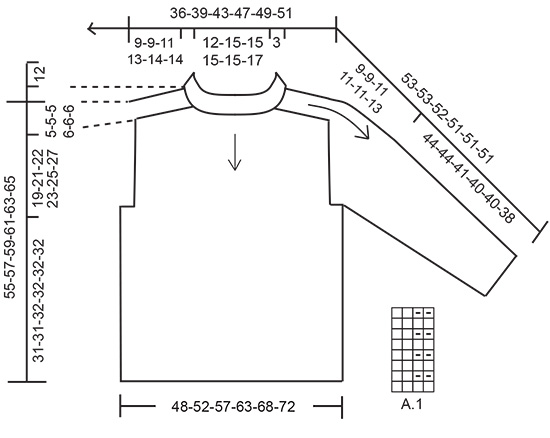
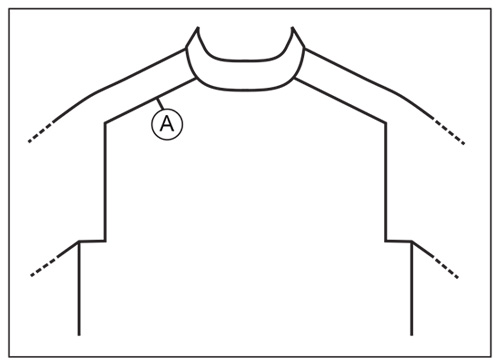
What can you do with our patterns? You can share DROPS patterns online, using the pattern original picture, materials, name and number. But you are NOT ALLOWED to reproduce the complete pattern digitally in any way. Yarn stores are welcome to use the DROPS pattern database to promote the sale of our assortment. You can print out our patterns, make as many copies as you’d like. The only thing we ask is that you don't make any changes / additions to the original printed document. And that the patterns according to the DROPS philosophy are given out to the consumers for free. Editorials that wish to publish our patterns in printed books or magazines can contact us for more information. The sale of garments based on DROPS patterns is permitted as long as they are sold as single items or per order. Further commercial use of the patterns is not permitted. It has to be clearly stated that the garment is made based on a design from DROPS DESIGN. The use of clothing labels of which DROPS DESIGN forms part is conditioned by the inclusion of the following text: “A DROPS DESIGN made by …..”. The use of DROPS photos for marketing purposes/sales is only permitted in connection with the use/sale of DROPS products. The photos may not be cut or edited and the logo should be clearly visible.
We reserve the right to withdraw the permission for use of our patterns at any time, notwithstanding the reason.
Each of our patterns has specific tutorial videos to help you.
These step-by-step tutorials might also help you:
Why is the knitting/crochet tension so important?
Knitting tension is what determines the final measurements of your work, and is usually measured per 10 x 10 cm. It is provided like so: number of stitches in width x number of rows in height - eg: 19 stitches x 26 rows = 10 x 10 cm.
The knitting tension is very individual; some people knit/crochet loosely while others work tightly. You adjust the knitting tension with the needle size, which is why the suggested needle size is only meant as a guide! You need to adjust this (up or down) to ensure that YOUR knitting tension matches the knitting tension provided in the pattern. If you work with a different knitting tension than provided you will have a different yarn consumption, and your work will have different measurements than what the pattern suggests.
The knitting tension also determines which yarns can replace each other. As long as you achieve the same knitting tension you can replace one yarn with another.
See DROPS lesson: How to measure your tension/gauge
See DROPS video: How to make a gauge tension swatch
How do I know how many balls of yarn I need?
The required amount of yarn is provided in grams, eg: 450 g. To calculate how many balls you’ll need you first need to know how many grams are in 1 ball (25g, 50g or 100g). This information is available if you click on the individual yarn quality on our pages. Divide the amount required with the amount of each ball. For example, if each ball is 50g (the most common amount), the calculation will be as follows: 450 / 50 = 9 balls.
Can I use a different yarn than what the pattern suggests?
The important thing when changing from one yarn to another is that the knitting/crochet tension remains the same. This is so that the measurements of the finished piece will be the same as on the sketch provided. It is easier to achieve the same knitting tension using yarns from the same yarn group. It is also possible to work with multiple strands of a thinner yarn to achieve the knitting tension of a thicker one. Please try our yarn converter. We recommend you to always work a test swatch.
Please NOTE: when changing yarn the garment might have a different look and feel to the garment in the photo, due to individual properties and qualities of each yarn.
See DROPS lesson: Can I use a different yarn than the one mentioned in the pattern?
What are the yarn groups?
All our yarns are categorised into yarn groups (from A to F) according to thickness and knitting tension – group A contains the thinnest yarns and group F the thickest. This makes it easier for you to find alternative yarns to our patterns, should you wish to switch yarn. All yarns within the same group have a similar knitting tension and can easily replace each other. However, different yarn qualities have different structures and properties which will give the finished work a unique look and feel.
How do I use the yarn calculator?
At the top of all our patterns you’ll find a link to our yarn calculator, which is a helpful tool should you wish to use a different yarn than suggested. By filling in the yarn quality you wish to replace, the amount (in your size) and number of strands, the calculator will present good alternative yarns with the same knitting tension. Additionally it will tell you how much you’ll require in the new qualities and whether you’ll need to work with multiple strands. Most skeins are 50g (some are 25g or 100g).
If the pattern is worked with multiple colours, every colour will have to be calculated separately. Similarly, if the pattern is worked with several strands of different yarns (for example 1 strand Alpaca and 1 strand Kid-Silk) you will have to find alternatives for each, individually.
Why do you show discontinued yarns in the patterns?
Since different yarns have different qualities and textures we have chosen to keep the original yarn in our patterns. However, you can easily find options among our available qualities by using our yarn calculator, or simply pick a yarn from the same yarn group.
It is possible that some retailers still have discontinued yarns in stock, or that someone has a few skeins at home that they would like to find patterns for.
The yarn calculator will provide both alternative yarn as well as required amount in the new quality.
What size should I knit?
If you think it's hard to decide what size to make, it can be a good idea to measure a garment you own already and like the size of. Then you can pick the size by comparing those measures with the ones available in the pattern's size chart.
You'll find the size chart at the bottom of the pattern.
See DROPS lesson: How to read size chart
Why do I get the wrong knitting tension with the suggested needle size?
The needle size provided in the pattern serves only as a guide, the important thing is to follow the knitting tension. And since knitting tension is very individual, you will have to adjust the needle size to ensure that YOUR tension is the same as in the pattern – maybe you’ll have to adjust 1, or even 2 needle sizes, up or down to achieve the correct tension. For this, we recommend that you work test swatches.
Should you work with a different knitting tension than the one provided, the measurements of the finished garment might deviate from the measurement sketch.
See DROPS lesson: How to measure your tension/gauge
See DROPS video: How to make a tension/gauge swatch
Why is the pattern worked top-down?
Working a garment top-down provides more flexibility and room for personal adjustment. For example it is easier to try the garment on while working, as well as making adjustments to length of yoke and shoulder caps.
The instructions are carefully explaining every step, in the correct order. Diagrams are adjusted to the knitting direction and are worked as usual.
How do I work according to a knitting diagram?
The diagram depicts all rows/rounds, and every stitch seen from the right side. It is read from bottom to top, from right to left. 1 square = 1 stitch.
When working back and forth, every other row is worked from the right side and every other row is worked from the wrong side. When working from the wrong side, the diagram will have to be worked reversed: from left to right, knit stitches are purled, purl stitches are knit etc.
When working in the round every round is worked from the right side and the diagram are worked from right to left on all rounds.
See DROPS lesson: How to read knitting diagrams
How do I work according to a crochet diagram?
The diagram depicts all rows/rounds, and every stitch seen from the right side. It is worked from bottom to top, from right to left.
When working back and forth every other row is worked from the right side: from right to left and every other row is worked from the wrong side: from left to right.
When working in the round, every row in the diagram are worked from the right side, from right to left.
When working a circular diagram you start in the middle and work your way outwards, counter clockwise, row by row.
The rows usually start with a given number of chain stitches (equivalent to the height of the following stitch), this will either be depicted in the diagram or explained in the pattern.
See DROPS lesson: How to read crochet diagrams
How do I work several diagrams simultaneously on the same row/round?
Instructions for working several diagrams after each other on the same row/round, will often be written like so: “work A.1, A.2, A.3 a total of 0-0-2-3-4 times". This means you work A.1 once, then A.2 is worked once, and A.3 is repeated (in width) the number of times provided for your size – in this case like so: S = 0 times, M = 0 times, L=2 times, XL= 3 times and XXL = 4 times.
The diagrams are worked as usual: begin with the first row in A.1, then work the first row in A.2 etc.
See DROPS lesson: How to read knitting diagrams
See DROPS lesson: How to read crochet diagrams
Why are the sleeves shorter in larger sizes?
The total width of the garment (from wrist-to-wrist) will be larger in the larger sizes, despite the actual sleeves being shorter. The larger sizes have longer sleeve caps and wider shoulders, so there will be a good fit in all sizes.
Where on the garment is the length measured?
The measurement sketch/schematic drawing provides information regarding the full length of the garment. If it’s a jumper or a jacket the length is measured from the highest point on the shoulder closest to the neckline, and straight down to the bottom of the garment. It is NOT measured from the tip of shoulder. Similarly, the length of yoke is measured from the highest point on the shoulder and down to where yoke is split into body and sleeves.
On a jacket measures are never taken along bands, unless specifically stated. Always measure inside band stitches when measuring the length.
See DROPS lesson: How to read a schematic drawing
What is a repeat?
Diagrams are often repeated on the round or in height. 1 repeat is the diagram the way it appears in the pattern. If it says to work 5 repeats of A.1 in the round, then you work A.1 a total of 5 times after/next to each other in the round. If it says to work 2 repeats of A.1 vertically/in height you work the entire diagram once, then begin again at the start and work the entire diagram one more time.
Why does the piece start with more chain stitches than it’s worked with?
Chain stitches are slightly narrower than other stitches and to avoid working the cast-on edge too tight, we simply chain more stitches to begin with. The stitch count will be adjusted on the following row to fit the pattern and measurement sketch.
Why increase before the rib edge when the piece is worked top-down?
The rib edge is more elastic and will contract slightly compared to, for example, stocking stitch. By increasing before the rib edge, you avoid a visible difference in width between the rib edge and the rest of the body.
Why increase in the cast-off edge?
It’s very easy to cast off too tightly, and by making yarn overs while casting off (and simultaneously casting these off) you avoid a too tight cast off edge.
See DROPS video: How to bind off with yarn overs (yo)
How do I increase/decrease on every 3rd and 4th row/round alternately?
To achieve an even increase (or decrease) you can increase on, for example: every 3rd and 4th row alternately, like so: work 2 rows and increase on the 3rd row, work 3 rows and increase on the 4th. Repeat this until the increase is complete.
See DROPS lesson: Increase or decrease 1 st on every 3rd and 4th row alternately
How can I work a jacket in the round instead of back and forth?
Should you prefer to work in the round instead of back and forth, you may of course adjust the pattern. You’ll need to add steeks mid-front (usually 5 stitches), and follow the instructions. When you would normally turn and work from the wrong side, simply work across the steek and continue in the round. At the end you’ll cut the piece open, pick up stitches to work bands, and cover the cut edges.
See DROPS video: How to knit steeks and cut open
Can I work a jumper back and forth instead of in the round?
Should you prefer to work back and forth instead of in the round, you may of course adjust the pattern so you work the pieces separately and then assemble them at the end. Divide the stitches for the body in 2, add 1 edge stitch in each side (for sewing) and work the front and back pieces separately.
See DROPS lesson: Can I adapt a pattern for circular needles into straight needles?
Why is the pattern slightly different than what I see in the photo?
Pattern repeats can vary slightly in the different sizes, in order to get the correct proportions. If you’re not working the exact same size as the garment in the photo, yours might deviate slightly. This has been carefully developed and adjusted so that the complete impression of the garment is the same in all sizes.
Make sure to follow instructions and diagrams for your size!
How do I make a women’s size garment into a men’s size one?
If you have found a pattern you like which is available in women’s size it’s not very difficult to convert it to men’s size. The biggest difference will be the length of sleeves and body. Start working on the women size that you think would fit across the chest. The additional length will be worked right before you cast off for the armhole/sleeve cap. If the pattern is worked top-down you can add the length right after the armhole or before the first decrease on sleeve.
Regarding additional yarn amount, this will depend on how much length you add, but it is better with a skein too many than too few.
How do I prevent a hairy garment from shedding?
All yarns will have excess fibres (from production) that might come off as lint or shedding. Brushed yarns (ie hairier yarns) have more of these loose, excess fibres, causing more shedding.
Shedding also depends on what is worn under or over the garment, and whether this pulls at the yarn fibres. It’s therefore not possible to guarantee that there will be no shedding
Below are some tips on how to get the best result when working with hairier yarns:
1. When the garment is finished (before you wash it) shake it vigorously so the looser hairs come off. NOTE: do NOT use a lint roller, brush or any method that pulls at the yarn.
2. Place the garment in a plastic bag and put it in your freezer - the temperature will cause the fibres to become less attached to each other, and excess fibres will come off easier.
3. Leave in the freezer for a few hours before taking it out and shaking it again.
4. Wash the garment according to the instructions on the yarn label.
Why does my garment pill?
Pilling is a natural process that happens to even the most exclusive of fibers. It's a natural sign of wear and tear that is hard to avoid, and that is most visible in high friction areas of your garment like a sweater's arms and cuffs.
You can make your garment look as new by removing the pilling, using a fabric comb or a pill/lint remover.
In the meantime, you can read the questions and answers that others have left to this pattern or join the DROPS Workshop on Facebook to get help from fellow knitters/crocheters!
You might also like...
Sunday Vibes |
||||||||||
 |
 |
|||||||||
Knitted jumper in DROPS Sky and DROPS Kid-Silk. The piece is worked top down, with textured pattern and saddle shoulders. Sizes S - XXXL.
DROPS 218-7 |
||||||||||
|
------------------------------------------------------- EXPLANATIONS FOR THE PATTERN: ------------------------------------------------------- RIDGE/GARTER STITCH (worked back and forth): Knit all rows. 1 ridge in height = Knit 2 rows. PATTERN: See diagram A.1. The diagram shows all rows in the pattern from the right side. INCREASE TIP (for saddle shoulder increase): BEFORE MARKER: The new stitch will be twisted, leaning towards the right. Use left needle to pick up strand between 2 stitches from the round below, pick up strand from behind and knit stitch in front loop. AFTER MARKER: The new stitch will be twisted, leaning towards the left. Use left needle to pick up strand between 2 stitches from the round below, pick up strand from the front and knit stitch in back loop. DECREASE TIP (for sleeves): All decreases are worked from the right side! Decrease 1 stitch inside the 1 edge stitch on each side as follows: Work 1 edge stitch in garter stitch, slip 1 stitch as if to knit, knit 1 and pass the slipped stitch over the knitted stitch (= 1 stitch decreased), work until there are 3 stitches left, knit 2 together (= 1 stitch decreased) and 1 edge stitch in garter stitch. CASTING-OFF TIP: To avoid the cast-off edge being tight you can cast off with a larger size needle. If the edge is still tight, make 1 yarn over after approx. each 4th stitch at the same time as casting off; the yarn overs are cast off as normal stitches. ------------------------------------------------------- START THE PIECE HERE: ------------------------------------------------------- JUMPER – SHORT OVERVIEW OF THE PIECE: The neck and yoke are worked in the round with circular needle, top down, until the increases for saddle shoulders are finished. The shoulder stitches are placed on threads and the front and back piece finished back and forth, separately. The sleeves are worked back and forth with circular needle, top down. NECK: Cast on 64-72-72-80-80-88 stitches with circular needle size 6 mm, 1 strand Sky and 1 strand Kid-silk (= 2 strands). Knit 1 round, then work pattern A.1 in the round for 12 cm. REMEMBER THE KNITTING TENSION! Insert 1 marker at the beginning of the round (= approx. mid-back), the piece is measured from the first marker! Insert 4 more markers as follows: Insert 1st marker after 8-12-12-12-12-16 stitches (= half back piece), count 14-14-14-18-18-18 stitches (= shoulder), insert 2nd marker here, count 18-22-22-22-22-26 stitches (= front piece), insert 3rd marker here, count 14-14-14-18-18-18 stitches (= shoulder), insert 4th marker here, there are 10-10-10-10-10-10 stitches left on the round (= half back piece). SADDLE SHOULDER INCREASE: Continue with the pattern as before, and increase 4 stitches on round: Increase BEFORE 1st and 3rd marker, and AFTER 2nd and 4th marker – read INCREASE TIP. Increases are only on front piece and back piece and number of shoulder stitches remains the same. Increase like this every round 18-18-22-26-30-30 times in total, and then every 2nd round 2-2-2-2-2-2 times = 144-152-168-192-208-216 stitches. When all the increases are finished, the piece measures approx. 9-9-11-13-14-14 cm from the marker mid-back. Now divide for the front and back pieces (the 2 knitted stitches on each side of both shoulders are worked into the back and front pieces) as follows: Work the first 30-34-38-42-46-50 stitches (= half back piece), work the next 10-10-10-14-14-14 stitches before placing them on a thread (= shoulder), work the next 62-66-74-82-90-94 stitches (= front piece), work the next 10-10-10-14-14-14 stitches before placing them on a thread (= shoulder) and work the last 32-32-36-40-44-44 stitches (= half back piece). Cut the strand, place the back-piece on a thread and work the front piece. FRONT PIECE: = 62-66-74-82-90-94 stitches. Work back and forth with pattern as before and cast on 1 stitch at the end of the first 2 rows (= 1 edge stitch on each side) = 64-68-76-84-92-96 stitches. The new stitches are worked in GARTER STITCH – read description above. When the piece measures 19-21-22-23-25-27 cm from the marker, cast on 4-5-5-5-5-6 stitches at the end of the next 2 rows for the armholes = 72-78-86-94-102-108 stitches. The piece is now measured from here. The new stitches are worked in garter stitch (a total of 5-6-6-6-6-7 stitches in garter stitch on each side of the piece). Continue working until the piece measures 31-31-32-32-32-32 cm. Cast off with knit over knit and purl over garter stitch – read CASTING-OFF TIP. The jumper measures approx. 55-57-59-61-63-65 cm from the shoulder down. BACK PIECE: Work in the same way as the front piece. SLEEVE: The sleeve is worked back and forth, top down from the shoulder stitches. Insert a marker in the middle of the shoulder stitches. The sleeve is measured from this marker. With 1 strand of each quality and circular needle size 6 mm, knit up stitches from the right side inside the 1 edge stitch as follows: Start at the bottom-inside corner of the armhole and knit up 23-23-27-27-27-31 stitches as far as the shoulder stitches, work the 10-10-10-14-14-14 shoulder stitches in pattern as before, knit up 23-23-27-27-27-31 stitches down the other side of the armhole = 56-56-64-68-68-76 stitches. Work pattern (A.1) with short rows back and forth as follows: ROW 1 (= wrong side): 1 edge stitch in garter stitch, * purl 2, knit 2 (ridge) *, work from *-* as far as the shoulder stitches, work the 10-10-10-14-14-14 shoulder stitches in pattern as before, purl 2. Turn and tighten the strand to avoid a large hole. ROW 2: Work A.1 as before over the first 14-14-14-18-18-18 stitches, turn, tighten the strand to avoid a large hole. ROW 3: Work A.1 as before over the first 16-16-16-20-20-20 stitches, turn, tighten the strand to avoid a large hole. ROW 4: Work A.1 as before over the first 18-18-18-22-22-22 stitches, turn, tighten the strand to avoid a large hole. Continue back and forth like this, working 2 more stitches before turning on each row until there is 1 stitch left on each side; the short rows are now finished. The sleeve cap measures approx. 9-9-11-11-11-13 cm. Remove the marker and insert it in the middle of the row. THE PIECE IS NOW MEASURED FROM HERE. Work back and forth with textured pattern and 1 edge stitch in garter stitch on each side. When the sleeve measures 7-7-7-7-7-8 cm from the end of the short rows, decrease 1 stitch on each side – read DECREASE TIP. Decrease like this every 3-3-2-1½-1½-1 cm a total of 8-8-10-12-12-14 times = 40-40-44-44-44-48 stitches. Continue working until the sleeve measures 44-44-41-40-40-38 cm – or to desired length. Cast off with knit over knit and purl over garter stitch – remember CASTING-OFF TIP. Work the other sleeve in the same way. ASSEMBLY: Sew the sleeve seams inside the 1 edge stitch on each side and sew the sleeves to the 4-5-5-5-5-6 stitches cast on for the armholes. Sew the side seams from the armholes and down, leaving 17 cm for the split. |
||||||||||
Diagram explanations |
||||||||||
|
||||||||||

|
||||||||||

|
||||||||||
|
Have you made this or any other of our designs? Tag your pictures in social media with #dropsdesign so we can see them! Do you need help with this pattern?You'll find tutorial videos, a Comments/Questions area and more by visiting the pattern on garnstudio.com. © 1982-2024 DROPS Design A/S. We reserve all rights. This document, including all its sub-sections, has copyrights. Read more about what you can do with our patterns at the bottom of each pattern on our site. |
||||||||||
With over 40 years in knitting and crochet design, DROPS Design offers one of the most extensive collections of free patterns on the internet - translated to 17 languages. As of today we count 304 catalogues and 11422 patterns - 11422 of which are translated into English (UK/cm).
We work hard to bring you the best knitting and crochet have to offer, inspiration and advice as well as great quality yarns at incredible prices! Would you like to use our patterns for other than personal use? You can read what you are allowed to do in the Copyright text at the bottom of all our patterns. Happy crafting!









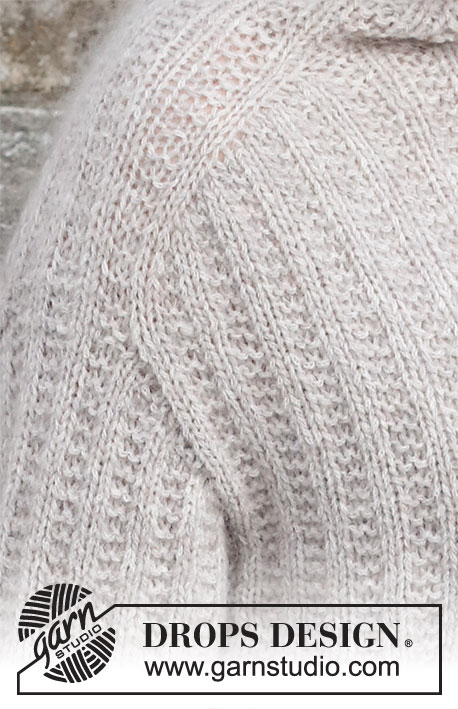

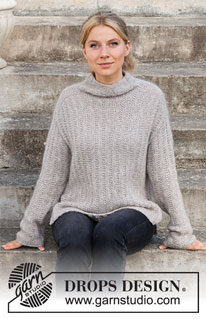
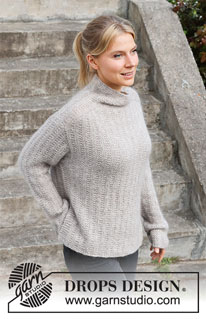

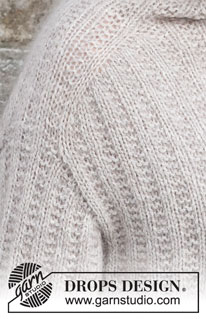





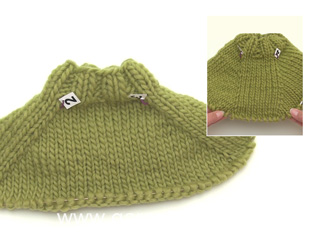














































Comments / Questions (18)
Hei! Spørsmål ang skulder økning størrelse M. Har 72m på pinne, så skal man øke 1 før & 1 etter skulder. "Øk slik på hver omg totalt 18 ganger og på hver 2.omg 2ganger = 152m", men jeg får ikke matten til å stemme. Blir helt gæren. Skal jeg øke 4m, så 8m, så 4m, så 8m i 18 omg? Da får jeg 108m bare. 152 tallet, skal det være total m på pinne etter økning eller er det antall m laget ved å øke? Hjelp!
24.01.2021 - 20:34DROPS Design answered:
Hei Camilla. Du starter med 72 masker på pinnen. Så skal det økes på hver omgang med 4 masker 18 ganger (18 x 4 masker = 72 økte masker) + 2 ganger der det økes på hver 2. omgang (2 x 4 =8). Da blir det 72 masker + 72 økte masker + 8 økte masker = 152 masker. God Fornøyelse!
01.02.2021 - 09:42Guten Tag Stimmt die Menge (Grösse L 250 gr. Sky / 100 gr Kid Silk) des Material für diesen Pullover? Mir scheint es, dass es zuwenig ist. Können Sie mir die Menge bestätigen? Vielen Dank für die Unterstützung.
20.01.2021 - 07:10DROPS Design answered:
Liebe Maria, so stimmt es, Sie brauchen 200 g DROPS Sky (4 Knäuel) und 100 g DROPS Kid-Silk (4 Knäuel) in der Größe S mit einer Maschenprobe von 15 Maschen in der Breite und 24 Reihen in der Höhe im Strukturmuster (= A.1) mit 1 Faden von jeder Garnqualität (= 2 Fäden). Hier lesen Sie mehr über die Maschenprobe. Viel Spaß beim stricken!
20.01.2021 - 07:52Ich würde diesen Pullover gerne mit Puna 06 und Kid Silk stricken. Das Puna Garn in Grau natural mix habe ich schon. Welche Farbe von Kid Silk passt dazu?
03.12.2020 - 16:11DROPS Design answered:
Liebe Undine, wenden Sie sich bitte direkt an Ihrem DROPS Laden, gerne wird man Ihnen die beste passen Farbe empfehlen - auch telefonisch oder per E-Mail. Viel Spaß beim stricken!
03.12.2020 - 16:43Hallo, auf den Fotos sieht es nach einem einfachen 2re / 2li Muster aus - das Diagramm zeigt aber etwas anderes? Vielen Dank
21.11.2020 - 21:04DROPS Design answered:
Liebe Sigrid, ja genau, Muster is 2 Maschen rechts, 2 Maschen kraus rechts (=diese 2 Maschen werden in runden abwechslungsweise rechts und links gestrickt). Viel Spaß beim stricken!
23.11.2020 - 08:59I'm so sorry to be such a dunder Kopf but unless I go to the original pattern instructions, there is no English version of pattern or diagrams. English being my first language, lol over time I might learn to read Norwegian but I could use some help with this! Thank you ever so much. Looking forward ☺️ to your response.
27.09.2020 - 09:50DROPS Design answered:
Dear Heather, thanks for noticing, missing diagram text in US-English will be added - you can check it from the Uk-English pattern while pattern will be updated. Happy knitting!
28.09.2020 - 10:02I do not see the diagram on this page.
12.09.2020 - 18:16DROPS Design answered:
Dear Leora, you will find diagram A.1 next to the measurement chart (just below sleeve), it's a diagram worked over 4 sts and 8 rows. Happy knitting!
14.09.2020 - 10:02Hvorfor skal ikke for- og bakstykke strikkes sammen på rundpinne? Og hvorfor skal ikke ermene strikkes på rundpinne?
08.09.2020 - 13:42DROPS Design answered:
Hej Silje, det bliver lettere at strikke frem og tilbage med de forkortede pinde på ærmet. Men du må gerne strikke rundt om du hellere vil det :)
09.09.2020 - 13:56On your pattern you say.....FRONT PIECE: = 62-66-74-82-90-94 stitches. ......... The piece is now measured from here. The new stitches are worked in garter stitch (a total of 5-6-6-6-6-6-7 stitches in garter stitch on each side of the piece). I think it should be 5-6-6-6-6-7. I think you have one too many 6s listed in the stitches.
24.08.2020 - 00:33DROPS Design answered:
Dear Jodhi, thanks for your feedback, pattern will be edited asap. Happy knitting!
24.08.2020 - 09:03